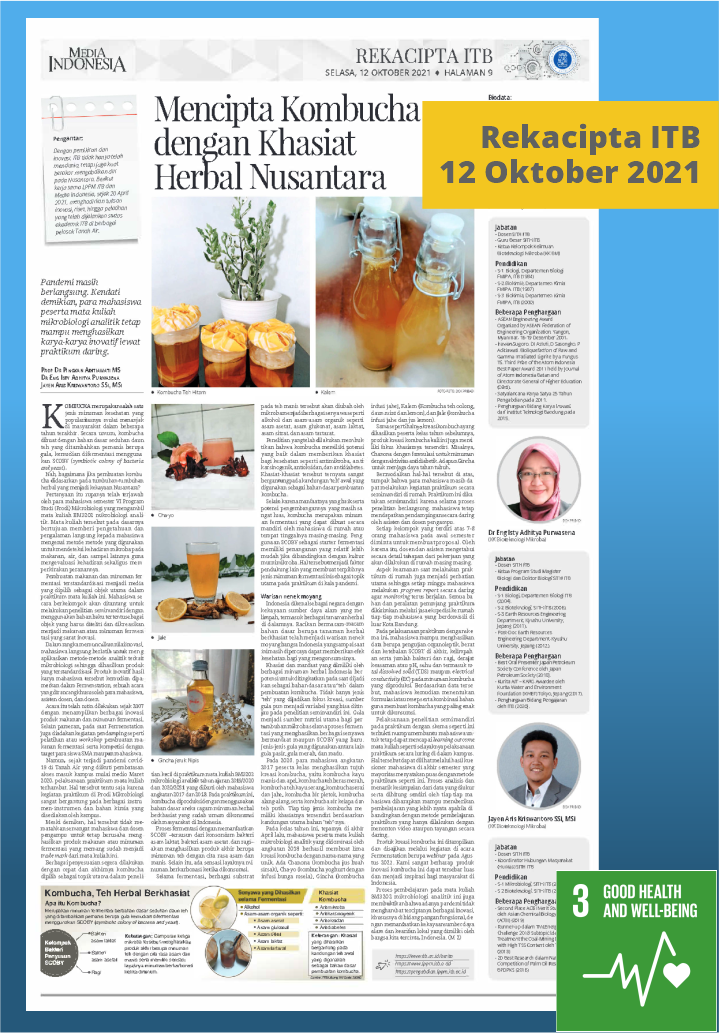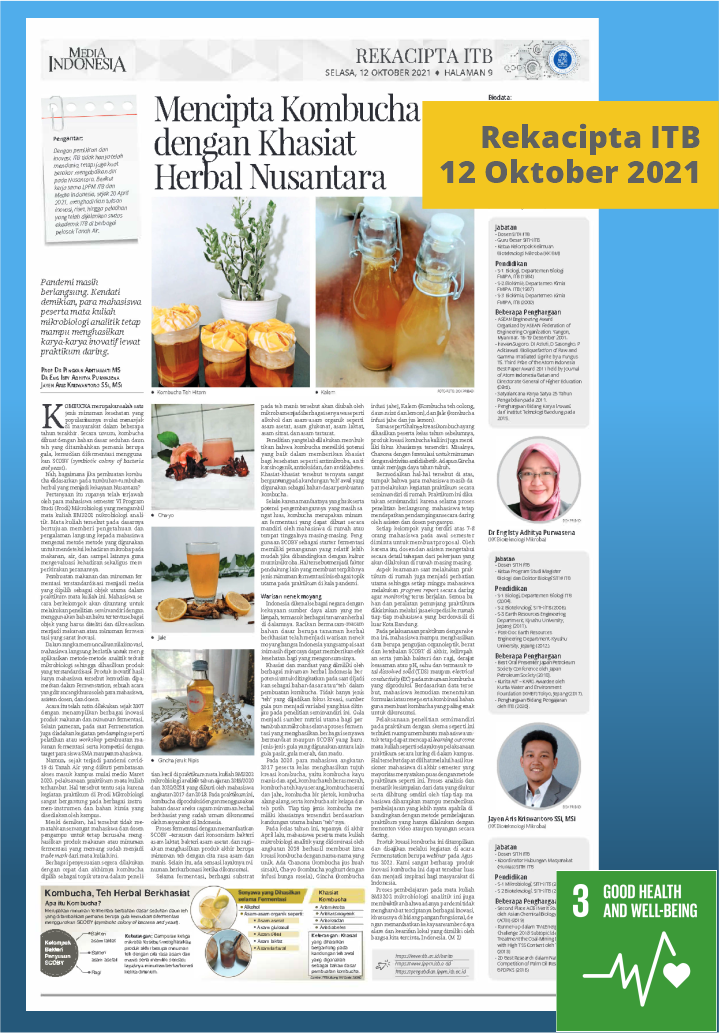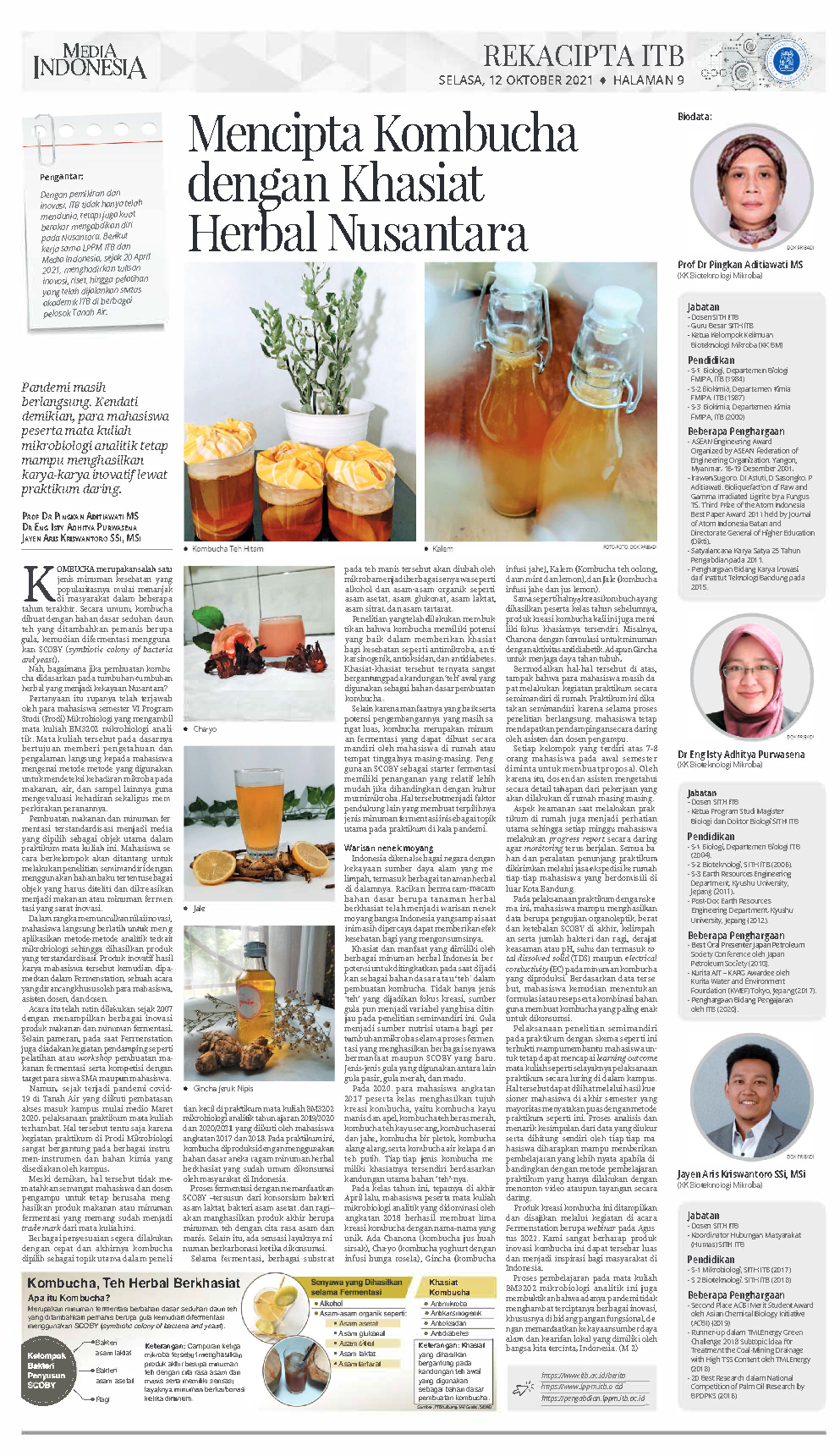

Creating Kombucha with Archipelago Herbal Benefits
Tags: ITB4People, Community Services, SDGs3
Kombucha is one type of health drink whose popularity has begun to rise in the community in recent years. In general, kombucha is made with the basic ingredients of steeping tea leaves which are added as a sweetener in the form of sugar, then fermented using SCOBY (symbiotic colony of bacteria and yeast).
Well, what if the making of kombucha is based on herbal plants that are the wealth of the archipelago?
The question seems to have been answered by the sixth semester students of the Microbiology Study Program (Prodi) who took the BM3202 analytical microbiology course. The course basically aims to provide students with direct knowledge and experience regarding the methods used to detect the presence of microbes in food, water, and other samples in order to evaluate their presence as well as to estimate their role.
The manufacture of standardized fermented foods and beverages is the media chosen as the main object in this course practicum. Students in groups will be challenged to conduct semi-independent research using certain raw materials as objects that must be researched and created into fermented foods or drinks that are full of innovation.
In order to bring out the value of innovation, students immediately practice applying analytical methods related to microbiology so that standardized products are produced. The innovative products made by students are then exhibited in Fermenstation, an event specially designed by students, lecturer assistants, and lecturers.
The event has been routinely carried out since 2007 by displaying various innovations of fermented food and beverage products. In addition to the exhibition, during the Fennenstation, there are also accompanying activities such as training or workshops on making fermented foods and competitions targeting high school students and college students.
However, since the COVID-19 pandemic in the country, which was followed by restrictions on campus access starting in mid-March 2020, the implementation of the course practicum has been hampered. This is of course because practicum activities in the Microbiology Study Program are very dependent on various instruments and chemicals provided by the campus.
However, this does not discourage students and lecturers from continuing to try to produce fermented food or drink products which have become the trademark of this course.
Various adjustments were immediately made quickly and finally kombucha was chosen as the main topic in a small study in the BM3202 analytical microbiology practicum course for the 2019/2020 and 2020/2021 academic years which was attended by students of the 2017 and 2018 batches. In this practicum, kombucha is produced using raw materials. the basis of a variety of nutritious herbal drinks that are commonly consumed by people in Indonesia.
The fermentation process using SCOBY - composed of a consortium of lactic acid bacteria, acetic acid bacteria, and yeast will produce the final product in the form of tea drinks with sour and sweet flavors. In addition, there is a sensation like a carbonated drink when consumed.
During fermentation, various substrates in sweet tea will be converted by microbes into various compounds such as alcohol and organic acids such as acetic acid, gluconic acid, lactic acid, citric acid, and tartaric acid.
Research has shown that kombucha has good potential in providing health benefits such as antimicrobial, anticarcinogenic, antioxidant, and antidiabetic. These properties are very dependent on the content of the initial 'tea' which is used as the basic ingredient for making kombucha.
Apart from its good benefits and wide potential for development, kombucha is a fermented drink that can be made independently by students at home or where they live. The use of SCOBY as a fermentation starter has a relatively easier handling when compared to pure microbial culture. This is another supporting factor that makes this type of fennentasi drink the main topic in the practicum during the pandemic.
Legacy of ancestors
Indonesia is known as a country with abundant natural resources, including various herbal plants in it. The concoction of various basic ingredients in the form of nutritious herbal plants has become a legacy of the ancestors of the Indonesian people which until now is still believed to have a health effect for those who consume them.
The properties and benefits of various Indonesian herbal drinks have the potential to be improved when used as a basic ingredient or 'tea' in the manufacture of kombucha. Not only the type of 'tea' that is used as the focus of creation, the source of sugar is also a variable that can be reviewed in this semi-independent study. Sugar is the main source of nutrition for microbial growth during the fermentation process which produces various beneficial compounds and new SCOBY. The types of sugar used include granulated sugar, brown sugar, and honey.
In 2020, the 2017 class participants produced seven komhucha creations, namely cinnamon and apple kombucha, brown rice tea kombucha, secang wood tea kombucha, lemongrass and ginger kombucha, beer pletok kombucha, alang-alang kombucha, coconut water and coconut water kombucha. white tea. Each type of kombucha has its own properties based on the main ingredients of 'tea' it.
In this year's class, at the end of last April, students participating in the analytical microbiology course dominated by the 2018 class managed to make five kombucha creations with unique names. There are Chanona (soursop fruit juice kombucha), Cha-yo (roselle flower-infused kombucha yogurt), Gincha (ginger-infused kombucha), Kalem (oolong tea, mint and lemon kombucha) and Jale (ginger and lemon juice-infused kombucha) .
Just like the kombucha creations made by the class participants last year, the kombucha creations this time also have a focus on their own benefits. For example, Chanona with a formulation for drinks with antidiabetic activity. There is also Gincha to maintain endurance.
With the things mentioned above, it appears that the students can still do practical activities semi-independently at home. This practicum is said to be semi-independent because during the research process, students still get online assistance by assistants and lecturers.
Each group consisting of 7-8 students at the beginning of the semester is asked to make a proposal. Therefore, lecturers and assistants know in detail the stages of work that will be neglected in their respective homes.
The security aspect when doing practicum at home is also a major concern so that every week students make progress reports online so that monitoring continues. All practicum supporting materials and equipment are sent via expedition service to the realm of each student who lives outside the city of Bandung.
In carrying out the practicum with this scheme, students are able to generate data in the form of organoleptic testing, weight and thickness of SCOBY at the end, abundance and number of bacteria and yeast, degree of acidity or pH, temperature and including total dissolved solid (TDS) and electrical conductivity (EC). in the manufactured kombucha drink. Based on this data, students then determine the formulation or recipe as well as the combination of ingredients to make the most delicious kombucha for consumption.
The implementation of semi-independent research in practicum with a scheme like this is proven to be able to help students to still be able to achieve the learning outcomes of the course as appropriate for the offline practicum on campus. This can be seen through the results of student questionnaires at the end of the semester, the majority of which stated that they were satisfied with this practicum method. The process of analyzing and drawing conclusions from the data measured and calculated by each student is expected to be able to provide more real learning when used

